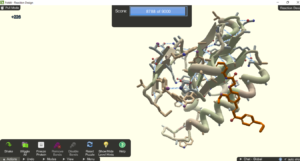This is the third week of the first section of the Computational Biology Internship. This week, we are wrapping up the Protein Modelling Internship with Professor Vladimir Yarov-Yarovoy and PhD Candidate Brandon Harris. Although I am sad I won’t see Mr. Harris and Professor Vladimir regularly for the next 2 weeks, I am very excited that they requested that we continue to help them after the internship is officially finished.
Next week, we will switch to the complementary field of Molecular Modelling, Molecular Dynamics, with Professor Igor Vorobyov, Professor Slava Bekker, and Graduate Student John Dawson. I am very excited to get to work with them and learn about their amazing, and very complicated, field.
This week started with a very insightful presentation from Dr. Yarov-Yarovoy about the future of computational biology and some problems in the field about which we should be aware. Dr. Vladimir started by showing us the behavior of voltage-gated ion channels in a very visual way (through a video where sodium ions were passing through the channel after having reached a certain electrical membrane potential, enough to make it open or close). I was able to see that ion channels are incredibly important to the future of medicine. By understanding the selectivity of ion channels, drugs can be manufactured to specifically interact with a channel (It is very important to study these since drugs will be more effective and side effects can be avoided).
Dr. Vladimir, then, briefly showed us electron cryotomography (ECT) which is an imaging technique used to obtain a three-dimensional view of macromolecules and cells. It was very interesting to learn about this technique and to see some pictures of bacteria and macromolecules taken using it.
On Wednesday, I had a very constructive meeting with Mr. Brandon Harris. I was able to learn about his scientific background and interests as well as about more detailed information on voltage-gated sodium ion channels and the many functions they can perform. I continue to be amazed at the diversity of protein structures and their uses. Mr. Harris is very good at explaining very complicated concepts, so I asked a lot of questions to understand the field even further. I usually don’t ask as many questions in my school classes, but it is totally different in the internship since there is always something new and challenging that I can learn. I intend to understand ion channels as much as I can, and Mr. Harris is willing for me to send him any related questions. I am very thankful for his help and very excited to learn more.
With respect to Rosetta, I was able to run my Relax and GALigandDock protocols successfully on Wednesday. It was very nice to see the programs running on the proteins I was assigned. The relax application will take a few days to run, but the GALigandDock application finished on Friday, just in time.
On Monday, we will analyze the data obtained from the GALigandDock protocol obtained from our common protein case, 6uz0. In order to analyze the outcomes, Mr. Harris taught us how to use the data on Rosetta to verify that the protein modelled is energetically favorable and biologically possible. The data looks very complicated and overwhelming, but Mr. Harris clarified our confusion by showing us an example of outcome data and how graphs can be used to analyze it. Afterward, through UCSF Chimera, the modelled protein was compared to the original protein (and the ligand) which was almost a perfect model. I am very excited to do that myself and see if the proteins I was assigned get to the level of accuracy Mr. Harris showed us.
Protein-Ligand Interactions through Foldit:
As you already know from the previous blogs, Foldit is a videogame that aids in the biology and computational visualization of the Rosetta software. This week was heavily computational and having a good understanding of protein-protein and protein-ligand interactions was very important. Luckily enough, the newest Foldit level was related to protein-ligand interactions, which is what the outcome data expresses, so I was able to ask questions and understand what Mr. Harris was presenting more in-depth.
This journey has been filled with incredibly great experiences, many challenges, and lots of quality practical and theoretical learning. I am very excited to be able to better understand and contribute to Mr. Harris’s job. His mentoring has made me try my hardest with its very challenging assignments and has motivated me to continue helping him after the internship.
When not in my internship, I was preparing for the upcoming SATs, I attended a virtual event from the SUMMET program from Colorado School of Mines, I read a book called: Mathematical mysteries, by Calvin C. Clawson , and I spent some time at my grandparents’ ranch.


There are no comments published yet.